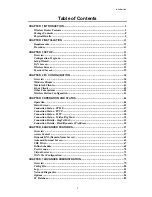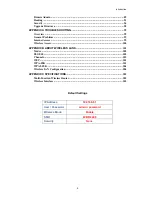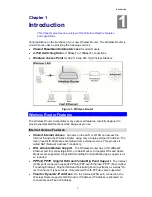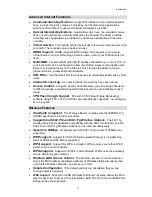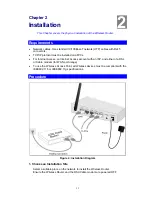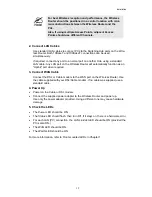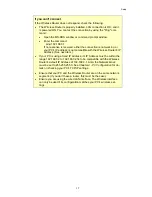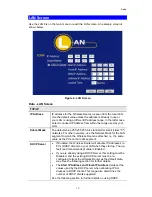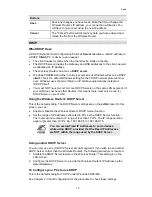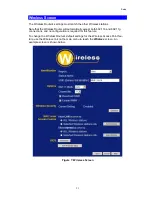
Introduction
7
WPS Support.
WPS (Wi-Fi Protected Setup) can simplify the process of con-
necting any device to the wireless network by using the push button configuration
(PBC) on the Wireless Access Point, or entering a 8-digit PIN code if there's no
button.
LAN Features
4-Port Switching Hub.
The Wireless Router incorporates a 4-port
10/100BaseT switching hub, making it easy to create or extend your LAN.
DHCP Server Support.
D
ynamic
H
ost
C
onfiguration
P
rotocol provides a
dynamic IP address to PCs and other devices upon request. The Wireless Router
can act as a
DHCP Server
for devices on your local LAN and WLAN.
Multi Segment LAN Support.
LANs containing one or more segments are
supported, via the Wireless Router's RIP (Routing Information Protocol) support
and built-in static routing table.
Configuration & Management
Easy Setup.
Use your WEB browser from anywhere on the LAN or WLAN for
configuration.
Configuration File Upload/Download.
Save (download) the configuration
data from the Wireless Router to your PC, and restore (upload) a previously-saved
configuration file to the Wireless Router.
Remote Management.
The Wireless Router can be managed from any PC on
your LAN. And, if the Internet connection exists, it can also (optionally) be confi-
gured via the Internet.
Network Diagnostics.
You can use the Wireless Router to perform a
Ping
or
DNS lookup
.
UPnP Support.
UPnP (Universal Plug and Play) allows automatic discovery and
configuration of the Wireless Router. UPnP is by supported by Windows ME, XP,
or later.
Security Features
Password - protected Configuration
. Optional password protection is
provided to prevent unauthorized users from modifying the configuration data and
settings.
Wireless LAN Security
. WEP (Wired Equivalent Privacy) is supported, as well
as Wireless access control to prevent unknown wireless stations from accessing
your LAN.
NAT Protection.
An intrinsic side effect of NAT (Network Address Translation)
technology is that by allowing all LAN users to share a single IP address, the loca-
tion and even the existence of each PC is hidden. From the external viewpoint,
there is no network, only a single device - the Wireless Router.
Firewall.
All incoming data packets are monitored and all incoming server re-
quests are filtered, thus protecting your network from malicious attacks from
external sources.
Protection against DoS attacks.
DoS (Denial of Service) attacks can flood
your Internet connection with invalid packets and connection requests, using so
much bandwidth and so many resources that Internet access becomes unavaila-
ble. The Wireless Router incorporates protection against DoS attacks.



